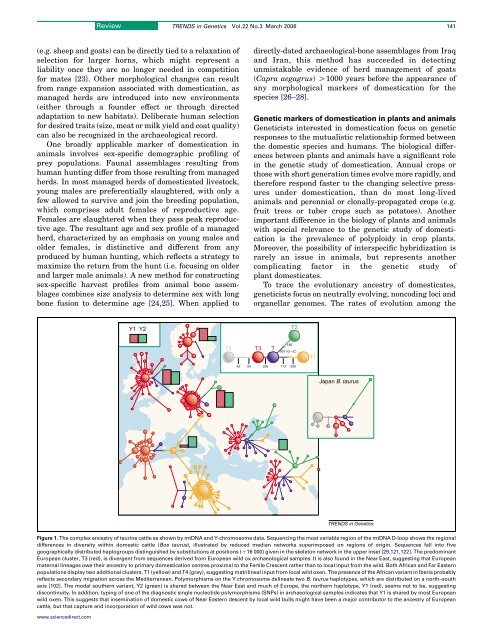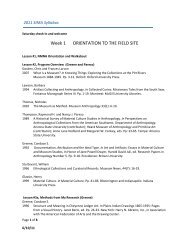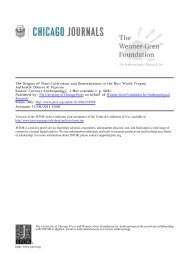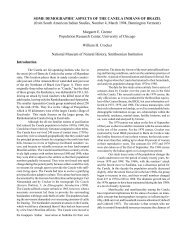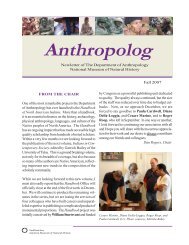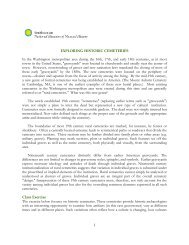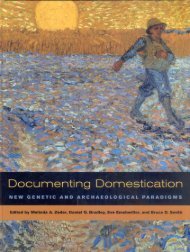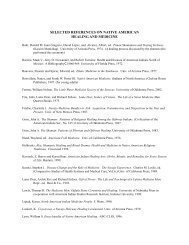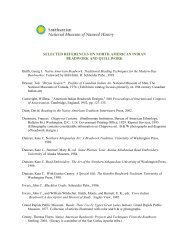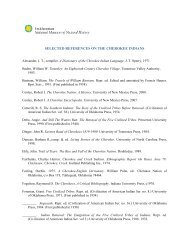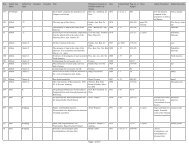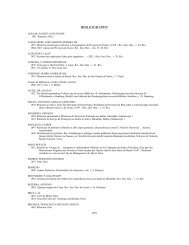Zeder, Melinda A, Emshwiller, Eve, Smith, Bruce D. - Anthropology ...
Zeder, Melinda A, Emshwiller, Eve, Smith, Bruce D. - Anthropology ...
Zeder, Melinda A, Emshwiller, Eve, Smith, Bruce D. - Anthropology ...
You also want an ePaper? Increase the reach of your titles
YUMPU automatically turns print PDFs into web optimized ePapers that Google loves.
Review TRENDS in Genetics Vol.22 No.3 March 2006 141<br />
(e.g. sheep and goats) can be directly tied to a relaxation of<br />
selection for larger horns, which might represent a<br />
liability once they are no longer needed in competition<br />
for mates [23]. Other morphological changes can result<br />
from range expansion associated with domestication, as<br />
managed herds are introduced into new environments<br />
(either through a founder effect or through directed<br />
adaptation to new habitats). Deliberate human selection<br />
for desired traits (size, meat or milk yield and coat quality)<br />
can also be recognized in the archaeological record.<br />
One broadly applicable marker of domestication in<br />
animals involves sex-specific demographic profiling of<br />
prey populations. Faunal assemblages resulting from<br />
human hunting differ from those resulting from managed<br />
herds. In most managed herds of domesticated livestock,<br />
young males are preferentially slaughtered, with only a<br />
few allowed to survive and join the breeding population,<br />
which comprises adult females of reproductive age.<br />
Females are slaughtered when they pass peak reproductive<br />
age. The resultant age and sex profile of a managed<br />
herd, characterized by an emphasis on young males and<br />
older females, is distinctive and different from any<br />
produced by human hunting, which reflects a strategy to<br />
maximize the return from the hunt (i.e. focusing on older<br />
and larger male animals). A new method for constructing<br />
sex-specific harvest profiles from animal bone assemblages<br />
combines size analysis to determine sex with long<br />
bone fusion to determine age [24,25]. When applied to<br />
Y1 Y2<br />
T4<br />
42<br />
93<br />
directly-dated archaeological-bone assemblages from Iraq<br />
and Iran, this method has succeeded in detecting<br />
unmistakable evidence of herd management of goats<br />
(Capra aegagrus) O1000 years before the appearance of<br />
any morphological markers of domestication for the<br />
species [26–28].<br />
Genetic markers of domestication in plants and animals<br />
Geneticists interested in domestication focus on genetic<br />
responses to the mutualistic relationship formed between<br />
the domestic species and humans. The biological differences<br />
between plants and animals have a significant role<br />
in the genetic study of domestication. Annual crops or<br />
those with short generation times evolve more rapidly, and<br />
therefore respond faster to the changing selective pressures<br />
under domestication, than do most long-lived<br />
animals and perennial or clonally-propagated crops (e.g.<br />
fruit trees or tuber crops such as potatoes). Another<br />
important difference in the biology of plants and animals<br />
with special relevance to the genetic study of domestication<br />
is the prevalence of polyploidy in crop plants.<br />
Moreover, the possibility of interspecific hybridization is<br />
rarely an issue in animals, but represents another<br />
complicating factor in the genetic study of<br />
plant domesticates.<br />
To trace the evolutionary ancestry of domesticates,<br />
geneticists focus on neutrally evolving, noncoding loci and<br />
organellar genomes. The rates of evolution among the<br />
T3<br />
T<br />
185<br />
T2<br />
057 (G→C)<br />
255 113 050<br />
T<br />
T1<br />
Japan B. taurus<br />
1<br />
TRENDS in Genetics<br />
Figure 1. The complex ancestry of taurine cattle as shown by mtDNA and Y-chromosome data. Sequencing the most variable region of the mtDNA D-loop shows the regional<br />
differences in diversity within domestic cattle (Bos taurus), illustrated by reduced median networks superimposed on regions of origin. Sequences fall into five<br />
geographically distributed haplogroups distinguished by substitutions at positions (C16 000) given in the skeleton network in the upper inset [29,121,122]. The predominant<br />
European cluster, T3 (red), is divergent from sequences derived from European wild ox archaeological samples. It is also found in the Near East, suggesting that European<br />
maternal lineages owe their ancestry to primary domestication centres proximal to the Fertile Crescent rather than to local input from the wild. Both African and Far Eastern<br />
populations display two additional clusters, T1 (yellow) and T4 (gray), suggesting matrilineal input from local wild oxen. The presence of the African variant in Iberia probably<br />
reflects secondary migration across the Mediterranean. Polymorphisms on the Y chromosome delineate two B. taurus haplotypes, which are distributed on a north–south<br />
axis [102]. The modal southern variant, Y2 (green) is shared between the Near East and much of Europe, the northern haplotype, Y1 (red), seems not to be, suggesting<br />
discontinuity. In addition, typing of one of the diagnostic single nucleotide polymorphisms (SNPs) in archaeological samples indicates that Y1 is shared by most European<br />
wild oxen. This suggests that insemination of domestic cows of Near Eastern descent by local wild bulls might have been a major contributor to the ancestry of European<br />
cattle, but that capture and incorporation of wild cows was not.<br />
www.sciencedirect.com


